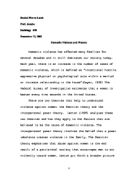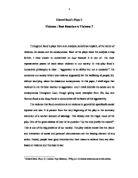Sexual violence is defined by anything that is related to physical attacks or abuse such as rape, attempted rape, any unwanted touching or act of a sexual nature, forced prostitution and child molestation. Sexual assaults often occur in a situation in which the abuser is in a position of trust in relation to the person who is being assaulted, such as a husband, father, other relative, doctor, coach, teacher, friend, employer, or a date. Rape is a common form of sexual assault and is committed in many situations.
“More than half of lifetime rapes occur before age 18, and nearly one-third occur before age 12. An estimated 683,000 rapes occur each year. Only 16% of rape victims report the offense to police.”
Violence against women is about control and bullying of women. It is a major problem in Canada, United States and in many other places around the World, as well as a major health and human rights concern. Women can experience physical or mental abuse throughout their lifecycle, in infancy, childhood and/or adolescence, or during adulthood or older age. While violence has severe health consequences for those who are the victims, it is a social problem that requires immediate attention in First, Second and Third World Countries. Violence against women in the family occurs in developed and developing countries. Up and including now, it has been considered a private matter by bystanders; including neighbors, the community and government. But private matters like that have a tendency to become public tragedies.
Worldwide, women are being treated violently for not obeying the husband, talking back, refusing sex, not having food ready on time, failing to care for the children or home, questioning the man about money or girlfriends or going somewhere without his permission.
“In the United States a women is beaten every 18 minutes. Without a doubt, domestic violence is the leading cause of injury among women in the United States. Between 22 and 35 per cent of women who visit emergency rooms are there for that reason”.
“Half of Canadian women have survived at least one incident of sexual or physical violence. Four out of five people murdered by their spouse are women murdered by men. Only 10 per cent of sexual assaults on women are reported to the police. Estimating from this data, there are 509,860 reported and unreported sexual assaults in Canada per year. That is 1,397 per day which means that every minute of every day, a women or child in Canada is being sexually assaulted.”
In many developing countries, women fall victim to traditional practices that violate their human rights. The continuity of the problem has a lot to do with the fact that most of these physically and psychologically harmful customs are closely related to the tradition and culture of society. Furthermore many cultures even allow or at least tolerate a certain amount of violence against women. In parts of South Asia, Western Asia and Africa, for example, men seem to have almost a right to discipline their wives whenever they feel the need to. Even these women sometimes see a certain amount of physical abuse as fair under certain conditions. For example, “80 % of women surveyed in rural Egypt said that beatings were common and often justified, particularly if the women refused to have sex with her partners.” (http://www.afrol.com/Categories/Women/wom003_violence_unfpa.htm)
Violence against women is a major public health and human rights problem throughout the world. “Worldwide, 20 to 50 percent of women experience some degree of domestic violence.” However the problem seems to be the worst in Asia, Africa and the Middle East Countries. In Africa, for example, domestic violence, rape and other sexual abuse and female genital mutilation are part of a separate category of concern. In South Africa, the incidence of rape is thought to be the highest in the world. Forced or unprotected sex puts women at risk of acquiring sexually transmitted diseases, including HIV/AIDS. Rape victims seem to be the ones especially at risk of infection. “Up to 30 per cent of women raped in the United States every year, for instance, develop an sexually transmitted disease as a result”. (http://www.afrol.com/Categories/Women/wom003_violence_unfpa.htm)
The term molestation means unwanted contact. Molestation of young girls is another deeply disturbing issue when it comes to violence against women. A study in Zaria, Nigeria, for example, found that “16 per cent of hospital patients with sexually transmitted infections were under age 5.” At the Genito-Urinary Center in Harare, Zimbabwe, “doctors discovered that more than 900 children under age 12 had been treated for a sexually transmitted disease in 1990 alone.”
Honor killings, is another very important and horrifying issue certain countries, especially the Middle East, deal with today. They are acts of violence committed by family members, usually for what is considered, “immoral behavior”. “An average of 25-30 women are killed in Jordan each year in the name of honor.” In most cases, a girl or woman is murdered by a family member for assumed violations of family honor. “Throughout the world, perhaps as many as 5,000 women and girls a year are murdered by members of their own families, many of them for the “dishonor” of having been raped, often as not by a member of their own extended family.”
“Sirhan, a 35-year-old murderer, is cheerful and relaxed and happy to tell his story. He's especially proud to describe the efficiency with which he shot his young sister Suzanne in the head four times last March. "She came to the house at 8:15," he relates, "and by 8:20 she was dead." Three days before, the 16-year-old girl had reported to police that she had been raped. "She committed a mistake, even if it was against her will," says Sirhan. "Anyway, it's better to have one person die than to have the whole family die from shame." (Beyer, The Price of Honor). A punishment for such a crime in the Arab world is not so much a punishment at all. If a man catches his wife or a close female relative in the act of adultery and kills her, he is excused from punishment. If the situation only suggests illegal sex, he's entitled to a reduced sentence. In such cases, jail terms range from a few months to a few years. Sirhan served six months. Not only is this cruel and vicious, it seems to be almost unrealistic.
Many forms of commonly allowed violence against women, such as “honor” killings, have something to do with the community’s or the family’s demand for sexual innocence or virginity. In Egypt, “a father paraded his daughter’s severed head through the streets shouting, “I avenged my honor”. Killings like that have been reported in Bangladesh (southern Asia), Egypt, India, Israel, Italy, Jordan, Morocco, Pakistan, Sweden, Turkey, Uganda and the United Kingdom. Throughout the world, women have little protection under the law from domestic violence. Few countries criminalize domestic violence, and even where they do, police and judges often treat it as a non-justifiable, private or family matter or, at best, an issue for civil, rather than criminal, courts.
Stopping and preventing violence against women worldwide, government should ensure that certain laws must be followed. For example, all forms of violence against women, including marital rape and other forms of domestic violence, should be criminalized with appropriately serious penalties. Police should take detailed evidence from all related people whenever a complaint of sexual and/or domestic violence is made. Women who report sexual and/or domestic violence should have free and frequent access to legal medical exams. Victims of domestic and sexual assault should be treated with fairness, compassion and respect.
Quality shelters or other safe spaces for battered women should be established. There, women can find safety and shelter without compromising their personal independence and freedom of movement. In addition support telephone hotlines for women victims of violence, should be made available. These hotlines should be widely publicized and operated by trained staff who can offer basic counseling and refer women to specialized service providers and to shelters. Hotlines for women in detention should be secure and confidential. Society at large, including judges and police officers, must be educated to change the social attitudes and beliefs that encourage male violence. (http://www.hrw.org/backgrounder/wrd/fiveplus.htm)
Violence against women happens all the time. Someone we know at this moment could be facing such a problem and we need to know how to help. Fighting violence against women requires challenging the way that gender roles and power relations are expressed in societies. In many countries women have a low status. They are considered as inferior and many men believe that they are superior to them and even have a right to own them. Changing people’s attitudes and approach towards women will take a long time, at least a generation and perhaps longer. Nevertheless, raising awareness of the issue of violence against women and educating boys and men to view women as valuable partners in life, in the development of a society and in the achievement of peace are just as important as taking legal steps to protect women’s human rights.







